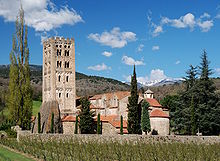- Saint-Michel-de-Cuxa
-
Saint-Michel-de-Cuxa (Catalan: Sant Miquel de Cuixà) is a Benedictine abbey located in the territory of the commune of Codalet, in the Pyrénées-Orientales département, in southwestern France. It was an important cultural centre in the regency of Abbot Oliva.
Foundation and apogee of the abbey
The origins of Cuixà abbey lie at Sant Andreu d'Eixalada abbey, founded in about 840, and located at the head of the Tet valley. In the autumn of 878, the river broke its banks, flooding and destroying the monastery (located near the river-bed) forcing the monks to seek refuge in the surrounding countryside. The community then transferred to Cuixà, a minor cenobitic community dedicated to Saint Germanus, led by Father Protasius.
In June 879, Protasius and Miro the Elder, count of Conflent and Roussillon, signed the founding treaty of the new monastery, whereby Cuixà extended its properties with those contributed by Eixalada and Protasius was named abbot.
The abbey continued under the protection of the count of Cerdanya and Conflent. The territory then came under the domain of the family of Wilfred I, count of Barcelona in 870. In about 940, under the initiative of Sunifred II of Cerdanya, a new church dedicated to Saint Michael was built. In 956 the building was refurbished and made more sumptuous; the main altar was consecrated on 30 September 974 by Garí, a monk from Cluny who led five southern monasteries.
When the Doge of Venice, Pietro I Orseolo, accepted Romuald's advice to become a monk, abdicated his office, and fled in the night, it was to Saint-Michel-de-Cuxa that he retired, accompanied by Romuald and his companion, Marinus, who established a hermitage nearby.
See also
Coordinates: 42°36′N 2°25′E / 42.6°N 2.417°E

This article related to Catalonia is a stub. You can help Wikipedia by expanding it.


